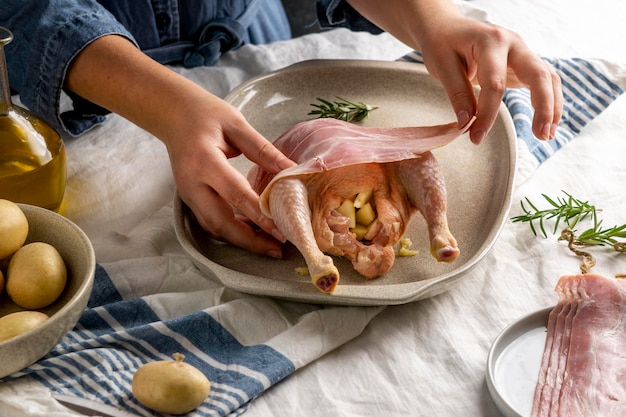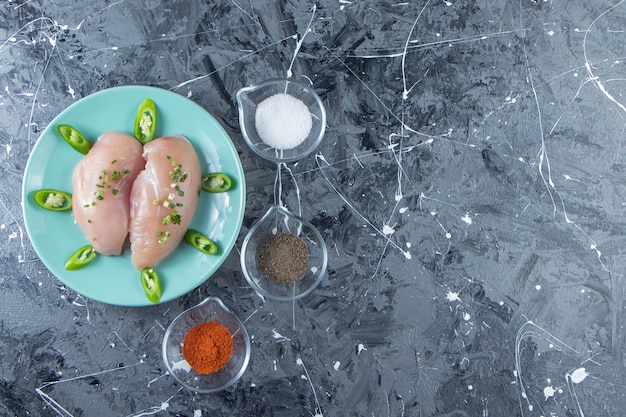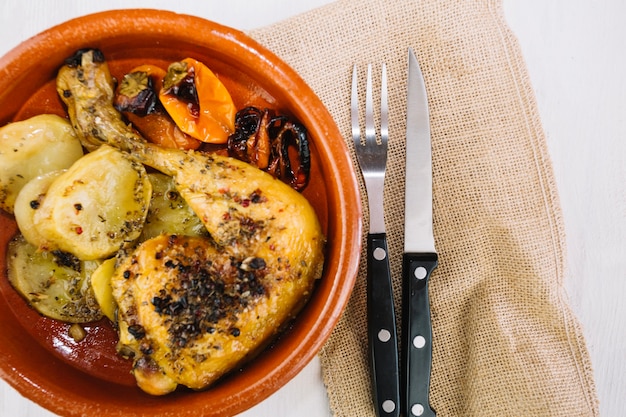(Part 1) The Cornish Chicken: A Star in Its Own Right

Why Cornish Chickens Are So Special
Now, you might be wondering why Cornish chickens are so sought after. Well, they're basically the rockstars of the chicken world. They're bred for their succulent flavour and tender, juicy meat, which makes them ideal for roasting. They're also a good size for a family meal, not too big and not too small, making them perfect for a delicious, satisfying meal without any leftovers.Choosing Your Cornish Chicken
When you're at the butcher's or supermarket, choose a chicken that looks plump and has a healthy, vibrant colour. Give it a good sniff, it should smell fresh. Don't be afraid to ask the butcher for advice, they're usually happy to help. I like to choose one that's got a bit of weight to it, as it'll mean more juicy meat for everyone.Beyond the Basics: Free Range and Organic
For a truly special meal, consider a free-range or organic Cornish chicken. These chickens are raised with more space and natural feed, resulting in a more flavorful and ethical choice. You might pay a little more, but the quality and taste difference is truly noticeable.(Part 2) Prepping Your Cornish Chicken: It's All About the Details

Getting Your Chicken Ready
Before you start cooking, you'll need to give your Cornish chicken a good rinse under cold water. Pat it dry with some kitchen paper, making sure to get into all the nooks and crannies. I always find this step is important for a crisp skin.A Flavorful Rub
This is where you can really get creative! I'm a big fan of using a simple mix of herbs and spices. Some of my go-to ingredients include rosemary, thyme, garlic, paprika, and a pinch of salt and pepper. Rub it all over the chicken, making sure to get underneath the skin too. This will infuse the meat with incredible flavour.Stuffing the Cavity
For a truly delicious twist, I often stuff the cavity with lemon slices, a couple of sprigs of rosemary, and some garlic cloves for extra flavour. It's like a little party in the chicken's belly! The citrus and aromatics will release their essence as the chicken cooks, creating a truly irresistible flavour profile.(Part 3) Cooking a Cornish Chicken: The Art of Roasting

Choosing Your Roasting Method
There are a few ways to cook a Cornish chicken, but I'm a big fan of roasting. It's simple, it's foolproof, and it allows the chicken to cook evenly. I usually preheat my oven to 180°C/350°F, but remember to always check the instructions on your chosen recipe.roasting time
The roasting time will depend on the size of your chicken. As a rule of thumb, a Cornish chicken will take about 45 minutes to an hour. But always check it's cooked through by inserting a skewer into the thickest part of the thigh - if the juices run clear, it's ready!Keeping it Juicy
To keep your chicken moist and juicy, you can either baste it with its own juices or place a pan of water on the bottom rack of your oven. The steam will help to create a tender and flavorful bird.roasting techniques: A Deeper Dive
Roasting with a Pan: Place the chicken on a roasting rack in a baking pan. This allows air to circulate around the chicken for even cooking and helps to drain excess fat. Roasting with a Lid: Cover the chicken with a lid or foil for the first part of the cooking time. This will help to trap steam and keep the chicken moist. High-Heat Finish: For a crispy skin, remove the lid or foil for the last 15 minutes of cooking. This allows the skin to brown and crisp up.(Part 4) Serving Up Your Cornish Chicken: A Feast for the Senses
Carving the Chicken
Once your chicken is cooked, let it rest for about 10 minutes before carving. This allows the juices to redistribute, giving you a juicier and tastier bird. I always like to use a sharp carving knife to get nice, clean slices.The Sidekick: Perfect Accompaniments
No Cornish chicken is complete without a selection of delicious sides. I love pairing mine with roasted root vegetables like potatoes, carrots, and parsnips. A side of green beans or broccoli adds a fresh touch, and a simple salad is always a winner.Sauce, Anyone?
Now, you don't have to have a sauce, but for me, it's the cherry on top. You can use the pan juices for a delicious gravy, or even try a creamy mustard sauce or a tangy lemon sauce.(Part 5) The All-Important Sides: A Feast for the Senses
A Roasting Masterclass
Roasted vegetables are a classic side for a Cornish chicken. They soak up the lovely chicken juices and get a beautiful golden-brown colour in the oven. My go-to combo is usually potatoes, carrots, and parsnips, but you can experiment with other root vegetables like sweet potatoes, beetroot, or even turnips.Flavour Combinations
For extra flavour, I'll often toss the vegetables with some herbs and spices before roasting. Rosemary and thyme work really well with chicken, but you can also add a little garlic powder, paprika, or even a pinch of chilli flakes. Don't be afraid to play around with different flavours until you find your perfect combination.Green Goodness
A side of green vegetables adds a refreshing element to your meal. Green beans, broccoli, or asparagus are all great options. You can simply steam them, saute them in a little butter, or roast them alongside the other vegetables.Salad Symphony
A simple salad is a must-have for a lighter touch. Mix some leafy greens, chopped vegetables like tomatoes and cucumbers, and a simple vinaigrette. You can also add some nuts, seeds, or cheese for extra texture and flavour.(Part 6) Going the Extra Mile: Making It Special
Turning Up the Heat: Spicy Options
If you like things a little bit spicier, there are plenty of ways to add heat to your Cornish chicken. You can add a teaspoon or two of chilli powder to your rub, stuff the cavity with some hot peppers, or even brush the chicken with a spicy glaze during cooking. Just be warned, a little goes a long way!Flavour Adventures
I've also experimented with other flavour combinations. For a Mediterranean twist, I'll use a blend of oregano, thyme, and lemon zest. For a more exotic flavour, I'll add a touch of ginger, garlic, and coriander. The possibilities are endless!Table Presentation
Don't underestimate the power of a beautiful table setting. A simple but elegant tablecloth, matching napkins, and a vase with fresh flowers can instantly elevate your meal. Serve the chicken on a platter with the sides arranged around it, and don't forget to put a little bit of sauce on the side.(Part 7) Beyond Roasting: Other Cooking Methods
The Magic of the Grill
For a crispy skin and smoky flavour, grilling is a great option. You can grill your Cornish chicken whole or in pieces. Just remember to watch it closely and turn it regularly to avoid burning. You can also add some wood chips to the grill for extra smoky flavour.The Simplicity of Pan-Frying
Pan-frying is a quick and easy way to cook a Cornish chicken. Cut it into pieces, season them generously, and pan-fry them over medium heat until golden brown and cooked through. You can add some butter or oil to the pan for extra flavour.The Elegance of Sous Vide
For those who want to take things to the next level, sous vide cooking is a great option. Seal the chicken in a vacuum bag, submerge it in a water bath at a precise temperature, and cook until it's perfectly tender and juicy. You can then finish the chicken by searing it in a pan or under the grill for crispy skin.(Part 8) The Big Reveal: Enjoying Your Masterpiece
The First Bite: A Moment of Pure Joy
Once you've carved the chicken and arranged your sides, it's time to dig in. Take a bite of the succulent chicken, savour the flavours, and enjoy the satisfaction of having created a delicious meal. It's moments like these that make cooking so rewarding.Sharing the Love: Feasting with Friends and Family
For me, cooking a Cornish chicken is all about sharing. It's a chance to gather with loved ones, enjoy a delicious meal, and create memories that will last a lifetime. So, next time you're looking for a special meal, give this recipe a try.FAQs
Q: How do I know if my Cornish chicken is cooked through?
A: The best way to check is to insert a skewer into the thickest part of the thigh. If the juices run clear, it's cooked through. If they're still pink, cook for a few more minutes.
Q: Can I roast my Cornish chicken with vegetables?
A: Absolutely! You can roast your chicken with potatoes, carrots, parsnips, or any other root vegetables you like. Just make sure to place the vegetables around the chicken and roast them at the same temperature.
Q: What's the best way to prevent my chicken from drying out?
A: Basting the chicken with its own juices or placing a pan of water on the bottom rack of your oven will help to keep it moist and tender. You can also cover the chicken with foil for the first part of the cooking time.
Q: What are some good ways to use leftover Cornish chicken?
A: Leftover Cornish chicken is a great ingredient for salads, sandwiches, pies, or soups. You can also shred it and use it in pasta dishes or tacos. Get creative and experiment with different recipes!
Q: Can I freeze a Cornish chicken?
A: Yes, you can freeze a Cornish chicken. Wrap it tightly in cling film and then in foil. It will keep in the freezer for up to 3 months. Thaw it in the fridge for 24 hours before cooking.
Q: What are some good tips for carving a Cornish chicken?
A: Use a sharp carving knife and work carefully to avoid tearing the meat. Start by removing the legs and thighs. Then, carve the breasts into slices. You can also use a pair of kitchen shears to cut through the backbone and separate the wings.
Q: What are some common mistakes people make when cooking cornish chicken?
A: A common mistake is overcooking the chicken. This can lead to dry, tough meat. Make sure to check the temperature of the chicken with a meat thermometer. Another mistake is not letting the chicken rest before carving. This can lead to the juices running out, making the meat dry. Finally, make sure to wash your hands and all surfaces thoroughly after handling raw chicken to prevent cross-contamination.
Q: Can I use a different type of chicken instead of Cornish chicken?
A: While Cornish chicken is a great choice for roasting, you can use other types of chickens, such as roasting chickens, broilers, or even whole chickens. Just adjust the cooking time accordingly. For example, a whole chicken will take longer to cook than a Cornish chicken.
Q: What are some other ways to make a Cornish chicken meal more special?
A: You can add a touch of luxury with a side of creamy mashed potatoes or a rich gravy. You can also use a special garnish, such as fresh herbs or roasted garlic cloves. And don't forget to choose a beautiful table setting to make the meal even more special!
I hope this guide helps you cook a delicious and memorable Cornish chicken meal. Enjoy!
Everyone is watching

Perfect Rice Every Time: The Ultimate Guide to Cooking Rice
Cooking TipsAs a self-proclaimed foodie, I've always been a bit obsessed with rice. It's the foundation of countless cuisi...

Prime Rib Roast Cooking Time Chart: Per Pound Guide
Cooking TipsPrime rib roast. Just the name conjures images of lavish dinners, crackling fires, and hearty laughter. It’s ...

The Ultimate Guide to Cooking Asparagus: Tips, Techniques, and Recipes
Cooking TipsAsparagus. The mere mention of this spring delicacy conjures up images of vibrant green spears, crisp and burs...

Ultimate Guide to Cooking the Perfect Thanksgiving Turkey
Cooking TipsThanksgiving. Just the word conjures up images of overflowing tables laden with delicious food, the scent of r...

How Long to Bake Potatoes in the Oven (Perfect Every Time)
Cooking TipsBaked potatoes are a staple in my kitchen. They're incredibly versatile, delicious, and surprisingly easy to m...
